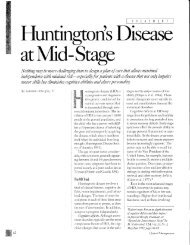Understanding Behavior in HD.final.8-18-05 - Huntington's Disease ...
Understanding Behavior in HD.final.8-18-05 - Huntington's Disease ...
Understanding Behavior in HD.final.8-18-05 - Huntington's Disease ...
You also want an ePaper? Increase the reach of your titles
YUMPU automatically turns print PDFs into web optimized ePapers that Google loves.
4<br />
UNDERSTANDING BRAIN COMMUNICATION AND CIRCUITRY<br />
The caudate is a very important structure because it has multiple connections with, or circuits to, other<br />
parts of the bra<strong>in</strong>. A circuit is a pathway by which <strong>in</strong>formation travels <strong>in</strong> the bra<strong>in</strong>. These circuits run through<br />
the caudate carry<strong>in</strong>g <strong>in</strong>formation from one part of the bra<strong>in</strong> to another. Bra<strong>in</strong> circuits operate much like other<br />
circuits that we are familiar with <strong>in</strong> our daily lives. For example, a light bulb can fill a room with light with the<br />
flick of a switch that allows the electrical current to travel through the circuit. The light bulb cannot give off<br />
light if the circuit is disconnected or<br />
blocked <strong>in</strong> any way.<br />
The bra<strong>in</strong> works <strong>in</strong> a similar manner<br />
such that behavior occurs without difficulty<br />
when the circuits are operat<strong>in</strong>g properly. As<br />
the caudate deteriorates, however, some<br />
circuits may “flicker” on and off and other<br />
circuits will cease work<strong>in</strong>g, with the result<br />
that the messages just don’t get through from one part of the bra<strong>in</strong> to the other. Consider the circuits<br />
operat<strong>in</strong>g <strong>in</strong> your home. The circuits that operate your lights are “one-way” circuits, light switch to light bulb.<br />
There are also circuits that allow two-way communication, or feedback, to occur. A good example of a two-way<br />
circuit is the heat<strong>in</strong>g and cool<strong>in</strong>g system <strong>in</strong> your home. A thermostat is used to set the desired temperature <strong>in</strong><br />
your home. The furnace turns on and off to heat the home. The room temperature is recorded on a<br />
thermometer, which is read by the thermostat. When the desired room temperature and the current room<br />
temperature are consistent with<br />
one another, no heat<strong>in</strong>g is<br />
required. When the room<br />
temperature is lower than the<br />
desired temperature, however,<br />
the heat<strong>in</strong>g system turns on.<br />
This circuit, as pictured on the<br />
left, requires that the heat<strong>in</strong>g<br />
system (the furnace) receive<br />
<strong>in</strong>formation from the<br />
thermostat to complete the<br />
circuit and produce the desired<br />
behavior (heat<strong>in</strong>g).

















